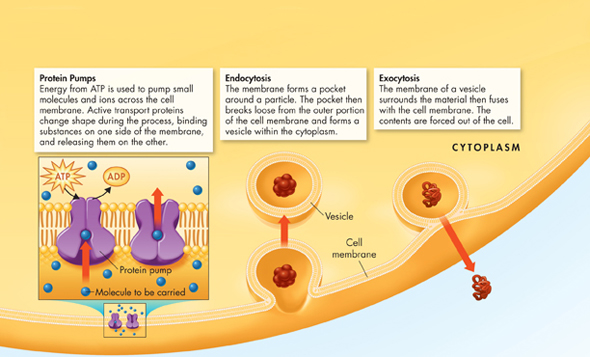VISUAL SUMMARY
ACTIVE TRANSPORT

FIGURE 7–19 Energy from the cell is required to move particles against a concentration gradient. Compare and Contrast What are the similarities and differences between facilitated diffusion and active transport by protein pump?
dActive Transport
 What is active transport?
What is active transport?
As powerful as diffusion is, cells sometimes must move materials against a concentration difference.  The movement of materials against a concentration difference is known as active transport. Active transport requires energy. The active transport of small molecules or ions across a cell membrane is generally carried out by transport proteins—protein pumps—that are found in the membrane itself. Larger molecules and clumps of material can also be actively transported across the cell membrane by processes known as endocytosis and exocytosis. The transport of these larger materials sometimes involves changes in the shape of the cell membrane. The major types of active transport are shown in Figure 7–19.
The movement of materials against a concentration difference is known as active transport. Active transport requires energy. The active transport of small molecules or ions across a cell membrane is generally carried out by transport proteins—protein pumps—that are found in the membrane itself. Larger molecules and clumps of material can also be actively transported across the cell membrane by processes known as endocytosis and exocytosis. The transport of these larger materials sometimes involves changes in the shape of the cell membrane. The major types of active transport are shown in Figure 7–19.
Molecular Transport Small molecules and ions are carried across membranes by proteins in the membrane that act like pumps. Many cells use protein pumps to move calcium, potassium, and sodium ions across cell membranes. Changes in protein shape seem to play an important role in the pumping process. A considerable portion of the energy used by cells in their daily activities is spent providing the energy to keep this form of active transport working. The use of energy in these systems enables cells to concentrate substances in a particular location, even when the forces of diffusion might tend to move these substances in the opposite direction.

Table of Contents
- Formulas and Equations
- Applying Formulas and Equations
- Mean, Median, and Mode
- Estimation
- Using Measurements in Calculations
- Effects of Measurement Errors
- Accuracy
- Precision
- Comparing Accuracy and Precision
- Significant Figures
- Calculating With Significant Figures
- Scientific Notation
- Calculating With Scientific Notation
- Dimensional Analysis
- Applying Dimensional Analysis




